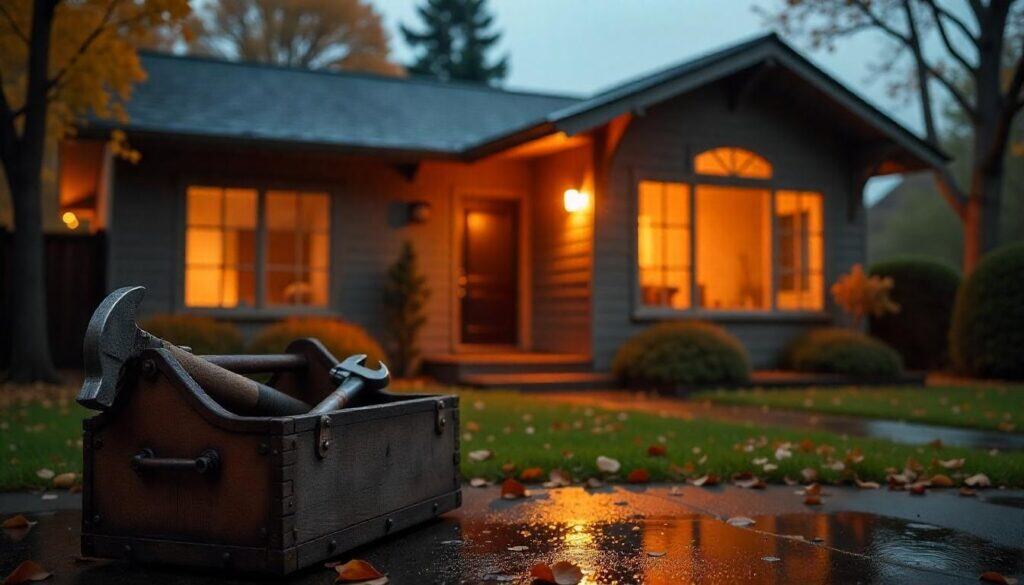
What Not To Fix When Selling a House: 5 Things in 2025
The real estate landscape has transformed dramatically following the National Association of Realtors’ (NAR) settlement in March 2024. These commission structure changes officially took effect on August 17, 2024, and we’re now seeing their real-world impact in early 2025. Despite early predictions of drastically lower buyer-agent commissions, the reality has been more nuanced—Redfin reports that average commissions have only decreased slightly from 2.45% to 2.37% since the rules were announced.
This evolving market creates a new calculus for home sellers. With buyers now directly negotiating compensation with their agents and potentially having less purchasing power as a result, every dollar you spend on pre-listing improvements must be scrutinized more carefully than ever. Knowing what not to fix when selling a house has become a critical strategy to attract buyers and maximize your net proceeds in this new commission environment. It’s essential to consider whether certain upgrades make financial sense, as not all improvements will yield a good return on investment.
What Not to Fix When Selling a House
The key to successfully preparing your home for sale is to think of it as an investment. Understanding the home selling process, including which strategic repairs and upgrades to make, is crucial. Every dollar you spend should potentially return more value at closing. Making unnecessary repairs can actually diminish your profit while extending your time-to-sale—a costly combination in a fluctuating market.
Let’s explore five specific areas where your renovation dollars might not yield the return you’re hoping for—allowing you to prioritize improvements that truly impact your bottom line while avoiding costly mistakes that drain your equity without adding value.
1. Minor Cosmetic Imperfections
Those small wall dings, slightly dated light switch covers, or that one cracked tile in the guest bathroom—they probably bother you more than they’ll bother potential buyers.
Minor cosmetic imperfections rarely affect your home’s value significantly. Buyers understand they’re purchasing a lived-in space, not a showroom model. In fact, with the new commission structures that have been in place since August 2024, prospective buyers are becoming increasingly aware of how repair requests impact their bottom line.
Today’s buyers are typically mentally prepared to handle small fixes themselves and often prefer to negotiate on price rather than wait for sellers to address every minor flaw.
Remember that the average buyer spends only 15-30 minutes in a home during a showing. In this rushed process, they’re primarily scanning rooms and absorbing the overall feel rather than scrutinizing every minor flaw. The small imperfections that jump out to you after years of living in the space often go completely unnoticed during brief showings.
Instead of spending time and money fixing every small imperfection, focus on thorough cleaning and decluttering. A clean, organized home allows buyers to see past minor flaws and envision themselves in the space. When selling your home, remember that strategic presentation often matters more than perfection.

2. Windows and Window Treatments
If your home has older windows with minor issues, complete replacement rarely provides sufficient return on investment. This is especially true in southern regions where broken window seals are common due to extreme temperature fluctuations.
When considering home repairs, these broken seals, which cause moisture between panes, are primarily an aesthetic issue rather than a functional one. Most buyers understand this is typical in certain climates. Unless the condensation severely obstructs visibility, repair is rarely worth the substantial cost (often hundreds of dollars per window).
Similarly, with window treatments, less is sometimes more. Rather than replacing broken blinds or outdated curtains, consider removing them entirely. This allows:
More natural light to enter the space
Rooms to appear larger and more open
Buyers to envision their own window treatment preferences
Modern real estate platforms now provide listing services that include professional photography optimized to showcase your home’s best features. These photos can strategically minimize attention to window imperfections while highlighting the natural light and spaciousness that come with treatment-free windows.
When deciding what not to fix when selling a house, windows and their accessories often fall squarely into the “leave alone” category. A thorough cleaning of the glass and frames can work wonders without the significant expense of replacement.
3. Minor HVAC, Electrical, or Plumbing Issues
With increased focus on what not to fix when selling a house, many sellers are reconsidering upgrades to functional but aging systems. HVAC, plumbing, and electrical systems should certainly be in working order, but completely replacing systems that still function adequately rarely provides sufficient return on investment.
There’s a common misconception that homes must be brought “up to code” before selling. This simply isn’t true for existing homes. Unless your house has dangerous electrical or plumbing problems that pose safety hazards, there’s typically no requirement to update these systems to current building codes.
For example, replacing an older but well-maintained HVAC system might cost $5,000-$10,000, yet buyers may not value this upgrade enough to pay significantly more for your home. Similarly, upgrading to “smart home” features or installing complex systems that require specialized knowledge might actually deter some buyers who prefer simplicity.
The exception? Necessary repairs to ensure these systems function properly. Addressing an outdated electrical service panel, for example, can enhance safety and appeal, providing a strong return on investment. A pre-listing home inspection report can help identify what truly needs addressing versus what’s simply aging but functional. By focusing only on essential repairs, you can save thousands while still presenting a home with working systems—a balanced approach that resonates with today’s buyers seeking value and transparency.
Technology-based real estate services often provide seller dashboards that show exactly what comparable homes in your area have sold for with similar system ages, helping you make data-driven decisions about whether repairs are truly necessary.
4. Partial Kitchen or Bathroom Renovations
While kitchens and bathrooms typically sell homes, partial renovations in these spaces often backfire. Updating just cabinets while leaving dated countertops, or installing new fixtures while ignoring worn flooring, creates a disjointed appearance that can actually highlight the unchanged elements.
These half-measures typically fall into what real estate professionals call “putting lipstick on a pig”—costly cosmetic fixes that don’t address the fundamental issues. Buyers often prefer a completely dated bathroom they can fully renovate to their taste over one with mismatched, partial updates that may not align with their personal taste.
Kitchen and bathroom renovations typically deliver the lowest return on investment among major home improvements. According to industry data, even complete kitchen remodels often return only 54-77% of their cost. Partial renovations fare even worse, sometimes actually decreasing a home’s perceived value.
When considering what not to fix when selling a house, these partial renovations should top your list. Instead, focus on:
Deep cleaning existing fixtures and surfaces
Decluttering countertops and storage areas
Making minor, cohesive updates (like hardware or lighting) that don’t clash with existing elements
This approach preserves your renovation budget while allowing buyers to envision their own complete renovation, rather than being stuck with your partial choices.
5. Flooring Replacements
New flooring, particularly carpet, rarely returns its cost at sale time. What’s more, flooring preferences are highly personal—the neutral beige carpet you install might be the first thing a new owner tears out in favor of hardwood floors or luxury vinyl.
In today’s market, the diversity of flooring preferences has expanded dramatically. Some buyers prioritize sustainable materials like bamboo or cork, while others prefer the practicality of luxury vinyl plank. The likelihood of selecting a universal crowd-pleaser is increasingly slim, making pre-sale flooring replacement an even riskier investment.
Unless your current flooring is severely damaged, stained, or odorous, investing in replacement before listing often amounts to wasted money. Consider these alternatives:
Professional steam cleaning for carpets
Refinishing rather than replacing hardwood
Strategic area rug placement to cover minor issues
The most informed sellers understand that when considering what not to fix when selling a house, flooring often represents one of the largest potential savings. Modern, tech-enabled real estate platforms can provide data on which flooring types appeal to buyers in your specific market, potentially saving you thousands in unnecessary replacements.
Making Smart Pre-Listing Decisions to Enhance Curb Appeal
Understanding what not to fix when selling a house helps sellers make wiser investments before listing. But how do you determine which repairs and improvements actually matter to buyers?
Ask yourself these critical questions before making any repairs:
Will this issue deter buyers from making an offer?
Could this repair cost more than I’ll recoup at closing?
Will this issue cause my house to sell for less than comparable homes?
Will this problem extend my home’s time on market, increasing carrying costs?
Would the buyer likely change this feature anyway after purchase?
This is where modern, tech-enabled real estate services offer distinct advantages. With data-driven insights about buyer preferences in your specific market, you can make informed decisions about which improvements will genuinely impact your home’s value.
These platforms provide sellers with transparent market analysis tools that help identify the most impactful pre-listing improvements. Rather than guessing what might appeal to buyers or following generic advice, you can make targeted investments based on actual market data.
By leveraging technology to guide your pre-listing improvements, you’ll likely spend less while achieving better results. This strategic approach becomes even more valuable in today’s real estate landscape, where commission structures and buyer expectations continue to evolve. Understanding the perceptions of prospective buyers is crucial, as their judgments can significantly influence the selling process.
New Commission Structures and Seller Strategies
With buyers now potentially paying their agents directly under the new NAR rules, many are entering the market with reduced purchasing power. This shift creates new considerations for sellers deciding what improvements to make before listing. Sellers should plan on spending money on essential tasks like deep cleaning and decluttering to enhance the home’s appeal. By focusing on these tasks, sellers can save money by avoiding unnecessary renovations that do not yield a good return.
The most successful sellers approach pre-listing improvements with even greater financial discipline than before. Rather than making changes based on personal preferences or generic advice, they leverage market data to identify which specific improvements actually influence buyer decisions in their neighborhood.
Modern listing platforms are particularly valuable in navigating these changes, as they combine technology with market expertise to analyze local sales trends. These platforms can show which features command premium prices in your specific area while offering significantly reduced listing fees compared to traditional models—a double advantage that helps preserve your equity in this evolving commission environment.
What You Should Fix Before Selling
While we’ve covered what not to fix when selling a house, some improvements do make sense to attract a potential buyer:
Light landscaping for curb appeal: First impressions matter. Inexpensive improvements like fresh mulch, trimmed shrubs, and colorful annuals can dramatically enhance your home’s appeal without breaking the bank.
Neutral paint: If your walls feature bold, personalized colors, a fresh coat of neutral paint creates a blank canvas that helps buyers envision their own style in the space.
Broken essentials: Anything that prevents comfortable living must be addressed. Non-functioning HVAC systems, water heaters, or major appliances should be repaired or replaced.
Outdated light fixtures: This relatively inexpensive update can modernize spaces instantly. Contemporary ceiling fans and lighting fixtures offer significant visual impact for minimal investment.
The key distinction: These improvements enhance marketability without excessive cost. They represent strategic investments rather than unnecessary expenditures.
The Bottom Line: Strategic Improvements Win When Selling a House
The most successful home sellers in 2025 will be those who understand that not every improvement adds value. By focusing on what not to fix when selling a house as is—avoiding window replacements, partial bathroom renovations, non-essential system upgrades, elaborate landscaping, and minor cosmetic repairs—you’ll preserve more equity while still attracting qualified buyers.
The goal when selling isn’t to showcase perfection, but rather to highlight potential. Today’s buyers often prefer making their own mark on a property, especially when they can purchase at a slightly lower price point and customize to their exact preferences.
The key lies in making strategic, targeted improvements rather than throwing money at pre-listing renovations. Technology-forward real estate platforms now offer flat-fee MLS listings with professional photography, digital lockboxes, and expert guidance—without charging the traditional 3% listing commission.
Ready to Sell Your Home Smarter in 2025?
Looking to maximize your home’s value without wasteful pre-listing expenditures? Understanding the home selling process, including strategic repairs and upgrades, can enhance your property’s appeal without incurring unprofitable costs or prolonging the selling process. ListingSpark provides sellers with data-driven insights, professional listing services, and significant commission savings. With our flat-fee structure and technology-powered platform, you’ll keep thousands more of your equity while still receiving all the professional support needed to sell successfully. Let’s get started.
Related Posts
How Do You Sell a House Without a Realtor in Georgia?
Selling a house without a realtor in Georgia is entirely possible—and it can save you thousands in real estate commission fees. But before jumping into the FSBO (For Sale By Owner) process, it’s important to…
How to Avoid Hurting Your Home Appraisal: Cleaning, Updating & Fixing
Renovating your home is a strategic investment aimed at enhancing its comfort and market value. However, sellers should approach these projects thoughtfully to avoid potential pitfalls that could negatively impact your property’s appraisal. For instance,…
Selling a House Without a Realtor in Texas: An Essential Guide
Selling a home is one of the largest financial transactions most people will ever make, and doing it without a realtor adds another layer of responsibility. While skipping the agent can save you thousands in…




